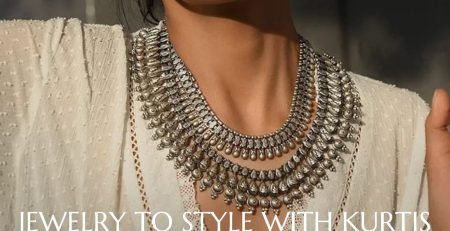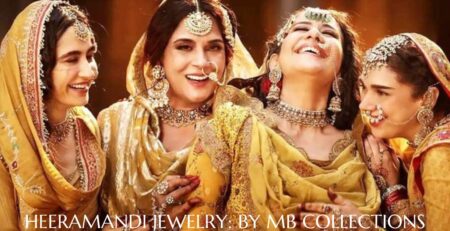THE EVOLUTION OF PAKISTANI FASHION JEWELRY
Introduction:
Pakistani fashion jewelry, known for its intricate designs and deep cultural significance, boasts a rich history that has spanned centuries. This article will explore the evolution of Pakistani fashion jewelry, tracing its journey from ancient traditions to contemporary styles. It highlights how this jewelry continues to captivate the hearts of people in Pakistan and around the world.
Historical Origins:
The ancient civilizations of the Indus Valley, dating back to around 2500 BCE, serve as the origin for Pakistani jewelry. Artisans of that era crafted simple designs, using beads, stones, and metals like copper and bronze. These early artifacts set the foundation for the intricate designs and styles that evolved in the ensuing centuries.
Influence of Various Dynasties:
Various dynasties, including the Persian, Afghan, and Mughal empires, have significantly influenced Pakistani jewelry design throughout history. Each era introduced its unique styles and techniques:
- The Mughal Influence: Particularly, the Mughal era profoundly impacted Pakistani jewelry. The Mughals introduced intricate designs, precious stones, and the art of enameling (Meenakari).
- Regional Diversity: Pakistan’s different regions developed their distinct jewelry styles. For example, Balochistan’s tribal jewelry, known for its bold and rustic designs, stands in stark contrast to the delicate and ornate pieces traditionally found in Punjab and Sindh.
Materials and Craftsmanship:
Gold, silver, and a variety of precious and semi-precious stones often feature in traditional Pakistani fashion jewelry. Craftsmen employ various techniques such as filigree, engraving, and stonework to create intricate designs.
Cultural Significance:
In Pakistan, jewelry serves not only as adornment but also carries immense cultural and symbolic significance. Pieces such as ‘Tikka’ (headpiece), ‘Jhoomer‘ (side headpiece), and ‘Nath‘ (nose ring) transcend their role as bridal accessories, symbolizing a woman’s marital status and her family’s heritage.
Contemporary Evolution:
In recent years, Pakistani jewelry has adopted modern design while preserving its traditional essence. Contemporary designers experiment with minimalist designs, unconventional materials, and fusion styles, blending Eastern and Western aesthetics.
Global Influence:
Today, designers showcase Pakistani fashion jewelry on international platforms, earning it global acclaim. This exposure not only brings Pakistani craftsmanship to the world stage but also facilitates a fusion of ideas and styles, further enriching the artistry of Pakistani jewelry.
The Role of Jewelry in Traditional Ceremonies and Rituals:
Pakistani jewelry transcends mere fashion, deeply embedding itself in the country’s cultural and traditional ceremonies. For instance, in weddings, specific jewelry types like the ‘Haar’ (necklace), ‘Bangles‘, and ‘Anklets‘ play a vital role. They act not just as adornments but also symbolize blessings and good wishes for the bride. In some regions, families consider certain jewelry pieces as heirlooms, passing them down through generations along with their stories and memories.
Artisan Communities and Their Techniques:
Skilled artisan communities, each specializing in various techniques and styles, maintain the craftsmanship of Pakistani jewelry. Artisans pass down the skill of ‘Kundan‘, the setting of stones without adhesive, through generations. Similarly, the ‘Polki’ style, featuring uncut diamonds, showcases the traditional techniques preserved over time. These communities form the backbone of the Pakistani jewelry industry, with their skills and dedication ensuring the survival of traditional techniques amidst modernization.
The Influence of Religion and Symbolism:
Religious and cultural symbolism significantly influences Pakistani jewelry design. Designers commonly incorporate Islamic motifs, like the crescent and star, into their creations. Often, artisans engrave jewelry pieces with calligraphy, including verses from the Quran or traditional blessings, adding a spiritual layer to the artistry.
Preservation and Revival of Ancient Techniques:
In Pakistan, a movement is growing to preserve and revive ancient jewelry-making techniques. Artisans and designers increasingly acknowledge the value of traditional methods and work actively to sustain these skills. This revival not only conserves cultural heritage but also endows Pakistani jewelry with a unique identity in the global market.
Jewelry as a Form of Expression in Modern Pakistani Culture:
In contemporary Pakistani culture, jewelry serves as more than an accessory; it becomes a medium of personal expression. Younger generations express their individuality through jewelry while maintaining a connection to their heritage. The increasing popularity of custom-made pieces, blending traditional motifs with modern designs, clearly demonstrates this trend.
The Future of Pakistani Jewelry:
Looking ahead, Pakistani jewelry’s future shines brightly and holds promise. Blending a rich history, cultural significance, and modern influences, it is set to continue evolving and adapting while preserving its unique identity. Designers experimenting with new materials and techniques are actively writing a new chapter in the story of Pakistani jewelry, honoring the past while welcoming the future.
Conclusion:
The evolution of Pakistani fashion jewelry weaves a rich and complex narrative from the threads of history, culture, art, and tradition. Spanning from its ancient roots to modern incarnations, it symbolizes the country’s diverse heritage and its people’s creative spirit. As this evolution progresses, Pakistani fashion jewelry will undoubtedly remain a cherished form of artistry and cultural expression, both within Pakistan and globally.











